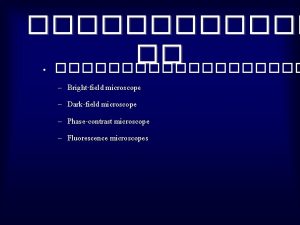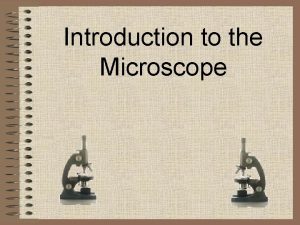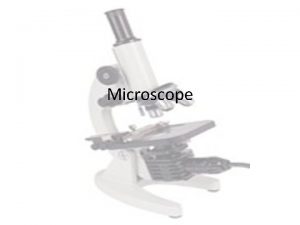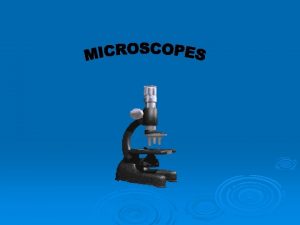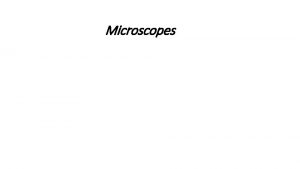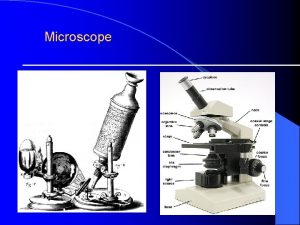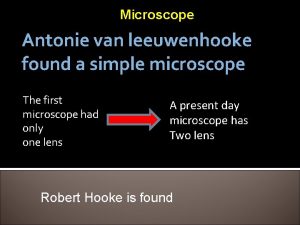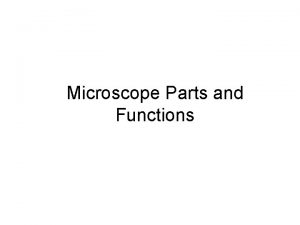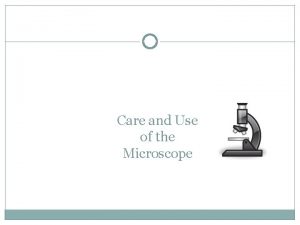The Microscope The Microscope n Simple Microscope one























- Slides: 23

The Microscope

The Microscope n Simple Microscope – one lens n Ex – Magnifying lens n Compound Microscope – 2 lenses that “compound” or magnify each other. n Dissecting Microscope – no special slide preparation

Microscopes

Parts of The Compound Microscope

Continued… n Eyepiece: n Magnifies material being viewed by 10 X n The part of the microscope you look into n Sometimes contains a pointer that can be seen as you look into the eyepiece. n May also be called the ocular.

Continued… n Nose piece: n Part of microscope to which the objectives are attached n Rotates to allow for the changing of objectives to increase or decrease magnification.

Continued… n Arm: n A secure part of the microscope to hold on to when the microscope is being carried.

Continued… n Objectives: n Low (4 x) n Medium (10 x) n High (40 x)

Continued… n Stage: n Platform on which microscope slide rests n Mechanical Slide Adjuster n Used for adjusting the position of the slide for viewing

Continued… n Coarse adjustment knob: n Large movements of the stage n Fine adjustment knob: n Precise focusing under High power

Continued… n Diaphragm: n regulates the amount of light passing through the slide

Continued… n Illuminator n Light source n Base: n provides support for microscope

Continued… n Body tube: n Connects Ocular to Nosepiece

TOTAL MAGNIFICATION n Power of the eyepiece (10 X) multiplied by objective lenses determines total magnification.

Magnification Objective Ocular Total Eyepiece Magnification Low Power 4 x 10 x 40 x Medium Power 10 x 100 x High Power 40 x 10 x 400 x

Field of View n Field of View (FV) is the illuminated circle that you see when looking through the ocular eyepiece. n If we know the diameter of the FV then we can estimate the size of our microorganisms.

Field of View n With our microscopes the diameter of the FV under low power is 4 mm n FV is measured in micrometers or microns. n 1 mm = 1000 microns n Therefore, our FV under low power is 4000 microns

Using the Field of View to Estimate Microscopic Measurements If an organism takes up ½ of the FV under low power, it must be about 2000 microns in length

How does the FV change as Magnification goes Up? ? n As magnification goes up, the size of the FV gets smaller. n If magnification increases 2 x, the FV is divided by 2 x, or 2 x smaller. n If we switch from low power (4 X) to medium power (10 X), the increase in magnification is 2. 5 times (10 X/4 X). n The FV under medium power will be 1600 microns (4000/2. 5)

Calculating the Diameter of the Field of View n Step 1 Calculate the Increase in Magnification. New Objective n Old Objective n Step 2 Divide the old F of V by the increase in magnification calculated in Step 1 n Old F of V (Microns) n Increase in Mag n

To Calculate the Changing FV n Low – 5 x; Med – 10 x; High – 50 x n Low FV = 5 mm (1000 um x 5 mm= 5000 um) n Step 1 – Calculate the increase in Magnification n Ex – 10 x/5 x = 2 n Step 2 – Calculate the reduction of the FV n 5000 um/2 = 2500 um

Let’s try High Power n Step 1 n Step 2 – 50 X

Electron Microscopy n SEM n TEM
 One empire one god one emperor
One empire one god one emperor Little dog run
Little dog run One king one law one faith
One king one law one faith One god one empire one emperor
One god one empire one emperor Ford one plan
Ford one plan See one do one teach one
See one do one teach one One price policy
One price policy Willow cabin speech
Willow cabin speech See one do one teach one
See one do one teach one One vision one identity one community
One vision one identity one community One vision one identity one community
One vision one identity one community Tennisone
Tennisone Difference between light microscope and electron microscope
Difference between light microscope and electron microscope Microscope mania compound light microscope
Microscope mania compound light microscope Present simple future simple past simple exercises
Present simple future simple past simple exercises Simple present and simple future
Simple present and simple future Past continuous present simple
Past continuous present simple презент перфект упражнения
презент перфект упражнения Simple past simple present simple future
Simple past simple present simple future Present simple past simple present continuous exercises
Present simple past simple present continuous exercises Simple future work
Simple future work Definition simple present
Definition simple present Present simple present continuous 4 класс
Present simple present continuous 4 класс Carry the microscope with one hand on the
Carry the microscope with one hand on the



























